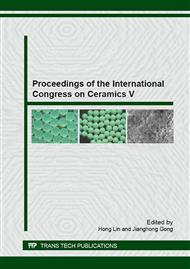p.103
p.108
p.114
p.118
p.122
p.126
p.132
p.136
p.141
Effect of Background Color to the Final Color of Four Highly Transparent Ceramics after Veneered
Abstract:
This study aimed to investigate the color value of four kinds of highly transparent ceramics (Zenostar Zirconia, Lava Zirconia, Cercon Zirconia and Upcera Zirconia)after veneered on three different post core materials including noble metal alloy, Co-Cr alloy and composite resin. Highly transparent ceramics after veneered were made into specimens with 10mm in diameter and 1.0mm in thickness. The color of core ceramics after veneered on different post core materials were measured with Color Analyzes. The results showed that their color value were significantly different from each other. Zenostar ZR Translucent and Lava Plus High Translucency Zirconia can be easily affected by the background color because of its high translucency. Therefore, resin post core materials should be selected without cause prosthesis mismatch of colors in clinical work. When making Cerconht full contour zirconia restorations, you could try to use a resin material as a post core material. And selecting precious metals, you had better make it opaque. Upcera zirconia owned a poor relative translucency, when making clinical restorations; you could use any kind of post core materials.
Info:
Periodical:
Pages:
122-125
Citation:
Online since:
July 2015
Authors:
Price:
Сopyright:
© 2015 Trans Tech Publications Ltd. All Rights Reserved
Share:
Citation:


